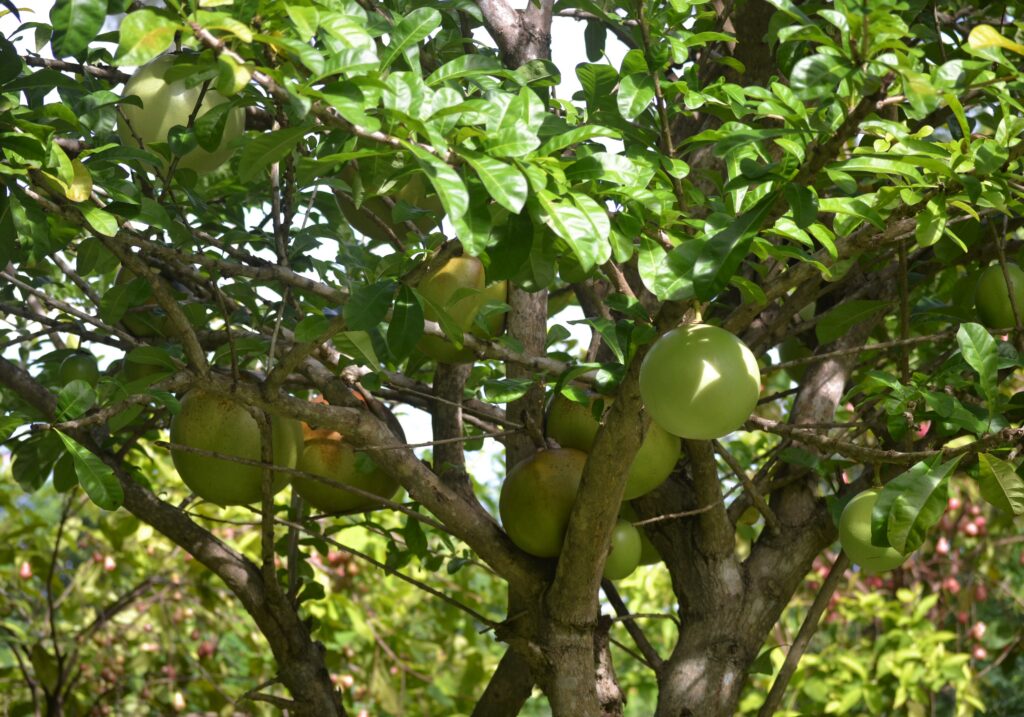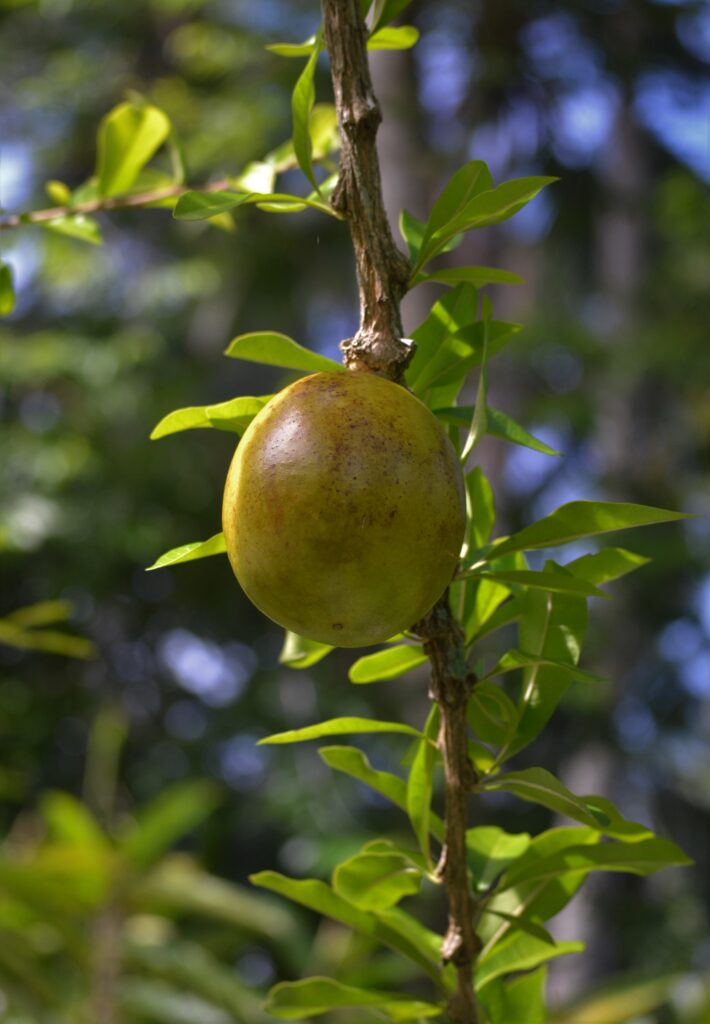Text and Photos by Henrylito D. Tacio
If there’s a plant that needs introduction in the Philippines, it’s the calabash tree. It has a strange fruit that never fails to catch the attention of whoever sees it, as it looks like a coconut and watermelon in appearance and size.
What is even more fascinating about the fruit is that it produces what has been described as a “miracle juice.” In her blog, a lady wrote: “Mama used to have a problem with her cholesterol but this juice put an end to it. She makes us drink it as well if we have colds, coughs, constipation and other illnesses.”
Known in the science world as Crescentia cujete, calabash is native to Central and South America, where it is called in various names: totumo in Colombia and Peru, mate in Ecuador, pate in Peru, jicaro in Mexico, and Higuera in Puerto Rico.
“The calabash tree has an interesting relationship with a few of the region’s animals,” wrote Ted Pan Deva Zagar, a Times correspondent. “Pollinated by bats during their nocturnal adventures, this plant produces a large but inedible fruit that provides Peruvian veterinarians with a cure for mange in dogs. Its soft brown bark makes an ideal growing medium for orchids, making this tree a host for lovely flowers in addition to its own.”
But it’s the fruit that possesses some healing powers. “Natural healers rely upon the pulp of the fruit to address respiratory conditions like asthma and to produce cough medicine,” Zagar wrote. “The fruit also has laxative properties. Externally, the flesh of the fruit helps heal skin conditions and takes care of unsightly bruises.”
Is it for real? Has it been proven scientifically? In General Santos City, a group of students from the Notre Dame of Dadiangas University found that “calabash extracts have the ability to prevent blood vessel growth and development.” As such, it “could be used to help prevent cancer cells in the human body.”
The students have analyzed the effects of fruit and leaf extracts of calabash to duck eggs. In their study, they found that the “extracts have successfully halted toe formation of new blood vessels as shown by the lower number of branching points in ducks embryo compared to the controlled samples.”
The Department of Science and Technology (DOST), through its Philippine Council for Health Research and Development (PCHRD), hailed the discovery. The students’ analysis, it said, showed that the tree’s “fruit and leaf extracts contain flavonoids such as quercetin and anthraquinone, the important phytochemicals for antiangiogenic activities, a process that inhibits the growth and development of new blood vessels in the body.”
Antiangiogenesis controls the spread of tumor cells in the body by disabling the transport of nutrients toward the cancerous cells, the PCHRD explained. Tumor cells, as they normally do, start with a single cell, which then divides into more cells. “The growth of malignant cells will depend on the availability of specific nutrients being transported by blood vessels,” it said.
In Davao City, the Davao Medical School Foundation has confirmed that calabash fruit has a blood sugar lowering effect on the tested animals.
In the website of PHCRD, which funded the study out of this regional research fund in Region XI, it was reported the researchers administered calabash fruit decoction (juice from boiled calabash fruit) to hyperglycemia-induced rabbits and compared effects to Metformin, a standard drug for the treatment of diabetics (positive control) and a mineral water treatment (negative control).
Analysis revealed that calabash fruit decoction and Metformin-treated rabbits showed “a significant decrease in the amount of blood sugar in the body. While rabbits administered with mineral water solution have constant high blood sugar levels.”
According to the study, “the decrease of blood sugar level was attributed to the effects of phytochemicals found in calabash fruit responsible for the release of insulin that lowers blood sugar in the tested animals.”
As stated earlier, calabash trees are not endemic in the Philippines. How it got into the country, no one knows. But it has become popular due to its miraculous properties. In fact, Bilma Masamloc Fuertes, who is from Davao City, called the product that is taken from the tree as Mary’s Miracle.
She came to know about the calabash because of her husband, who experienced a stroke four times. Since they didn’t have sufficient money for the medicine maintenance, she tried to process the calabash juice for him. She asked him to drink it, and within ten days, her husband reportedly was cured.
Because of this experience, she decided to sell it to others who are searching for alternatives to expensive drugs. But it was an uphill battle in the beginning as she knew people won’t buy it unless it is backed up by research and study. Believing in the fruit’s healing wonders, she went to the DOST to undergo training on better ways of producing the fruit juice.
According to Fuertes, the meat of the fruit is unstained white and has a foul odor. The juice, when extracted from the meat, turns greyish during the processing period.
“She sought financial assistance from the women’s sector and city government of Davao,” wrote Lorry B. De Jesus in a feature story of Fuertes, which appeared in Marid Agribusiness Magazine. “She also did thorough research for packaging as well as controlling the fruit’s odor. She also sought suggestions from her customers to help improve the product’s taste and presentation.”
It paid off. The Mary’s Miracle Juice is now a regular mainstay in most trade shows in Davao City. She has also attended some trade shows in Manila, believing that it is a step in capturing a bigger market.
“I won’t also stop researching not only about the juice but also to other beneficial results from miracle juice and other possible products from the fruit itself,” she was quoted as saying. “And I am very proud to tell everyone that generally we see the great potential to expand our business not only here in Davao or in the country but also to export it.”
So, how do you extract the juice out of the fruit? Chris Dearne, who has lived in General Santos City for several years now, gives some tips in his blog, “Live in the Philippines”:
But before extracting the juice, be sure to select a mature fruit. Here’s the reason: “If you choose an immature fruit, (the juice will have a smell) reminiscent of a football stadium urinal which has been starved of flushing water for a while!”
A fruit that has a pleasant but not strong smell is best for making juice. Now, the preparation: “Open the fruit and scrape out all the inside material. Chop them into small pieces and then squash it. Once it is well-squashed into a mush, boil it for 30 minutes before draining the juice through a clean cloth. Let the extracted juice cool before putting it into bottles. Place the bottles inside the refrigerator and simply drink it.”
Just like the miracle vegetable malunggay, every part of the calabash tree has its special use. The pulp, for instance, is very efficient in dealing with respiratory problems such as asthma and cold. The juice from the pulp is used along with cinnamon, anise, and nutmeg to prepare a herbal syrup which lessens chest disorders and treats gastrointestinal problems.
The decoction of the bark can be used to cure wounds. The leaves have the ability to decrease blood pressure and headaches. The leaves can also be crushed and applied to wounds to stop bleeding. If mixed with castor oil, it also acts as a purgative and laxative herb.
In Central America, where it is native, the leaves are carefully toasted and combined with other ingredients to prepare a drink called horchata. Other edible parts are the shoots and the tendrils.
According to Zagar, the wood of the tree is used to cure earaches and to reduce feverish conditions.
Calabash is also an ally in food preparation. In Chinese cuisine, it is often fried and added to soups. In Japan, people buy it in the form of marinated strips, which they use in making rolled sushi. In Burma, the leaves are boiled and eaten with a hot and spicy fish sauce.
But don’t use calabash too much in food preparation. It has been reported the fruit contains a toxic compound called tetracyclic triterpenoid cucurbitacin, which can trigger stomach ulcers. Pregnant women must also avoid consuming it as the fruit was once used to induce labor.



